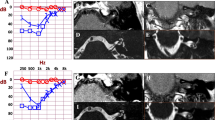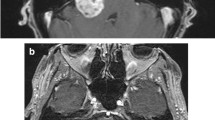Abstract
Purpose
Sporadic vestibular schwannoma (VS) is rare in children in contrast to adults, and detailed investigations of case series of these patients using a single fixed protocol are scarce. This study presents our surgical experience of pediatric VSs without clinical evidence of neurofibromatosis type 2 (NF2) at the initial diagnosis.
Methods
Among 1385 consecutive sporadic VS surgeries, 18 pediatric patients (1.3%; 11–18 years old) were retrospectively investigated.
Results
The most common initial symptom was hearing disturbance (72.2%), and 6 patients (33.3%) experienced a delayed diagnosis (over 2 years after initial symptom onset). Preoperative image characteristics of these tumors included a solid tumor, hypervascularity, and significant extension into the internal acoustic meatus, when compared with adults. Preoperative embolization was successfully accomplished for 2 recent hypervascular tumors. The tumor resection rate was 95–100% under sufficient intraoperative neuromonitoring, and no additional surgery was required during the follow-up period (average: 57.9 months). No patients experienced permanent facial nerve palsy, and serviceable hearing function was preserved in 6 of 11 patients. Signs of NF2, such as bilateral VSs, were not identified in any patients during the follow-up.
Conclusion
Safe and sufficient tumor resection was achieved under detailed neuromonitoring in pediatric patients with sporadic VS, although this tends to be difficult owing to hypervascularity, a small cranium, and significant meatal extension. Preoperative embolization may help safe resection of hypervascular tumors. Subsequent development of NF2 has not been observed up to the most recent follow-up, but careful observation is essential for these younger patients.



Similar content being viewed by others
Abbreviations
- ASL:
-
Arterial spin labeling
- ABR:
-
Auditory brainstem response
- CNAP:
-
Cochlear nerve action potentials
- CT:
-
Computed tomography
- MRI:
-
Magnetic resonance imaging
- NBCA:
-
N-Butyl cyanoacrylate
- NF2:
-
Neurofibromatosis type 2
- QOL:
-
Quality of life
- VS:
-
Vestibular schwannoma
References
The Committee of Brain Tumor Registry of Japan (2017) Brain Tumor Registry of Japan (2005–2008). Neurol Med Chir (Tokyo) 57(Suppl 1):9–102
Ostrom QT, Patil N, Cioffi G, Waite K, Kruchko C, Barnholtz-Sloan JS (2020) CBTRUS statistical report: primary brain and other central nervous system tumors diagnosed in the United States in 2013–2017. Neuro Oncol 30;22(12 Suppl 2):iv1-iv96
Allcutt DA, Hoffman HJ, Isla A, Becker LE, Humphreys RP (1991) Acoustic schwannomas in children. Neurosurgery 29:14–18
Harada K, Nishizaki T, Adachi N, Suzuki M, Ito H (2000) Pediatric acoustic schwannoma showing rapid regrowth with high proliferative activity. Childs Nerv Syst 16(3):134–137
Hodes PJ, Pendergrass EP, Young BR (1949) Eighth nerve tumors; their roentgen manifestations. Radiology 53(5):633– 665, 707–710
Malina GEK, Heiferman DM, Riedy LN, Szujewski CC, Rezaii EG, Leonetti JP, Anderson DE (2020) Pediatric vestibular schwannomas: case series and a systematic review with meta-analysis. J Neurosurg Pediatr 29:1–9
Mark VH, Sweet WH (1952) An unusual case of unilateral eighth nerve tumor. J Neurosurg 9(4):395–397
Pothula VB, Lesser T, Mallucci C, May P, Foy P (2001) Vestibular schwannomas in children. Otol Neurotol 22:903–907
Rushworth RG, Sorby WA, Smith SF (1984) Acoustic neuroma in a child treated with the aid of preoperative arterial embolization. Case report J Neurosurg 61:396–398
Wang J, Xu Y, Lei T, Zeng L (2015) Treatment decision-making for sporadic small vestibular schwannoma in a pediatric patient: a case report and literature review. Oncol Lett 9(5):2371–2373
Matsushima K, Kohno M, Nakajima N (2019) Hearing preservation in vestibular schwannoma surgery via retrosigmoid transmeatal approach. Acta Neurochir (Wien) 161:2265–2269
Teranishi Y, Kohno M, Sora S, Sato H, Nagata O (2018) Hypervascular vestibular schwannomas: clinical characteristics, angiographical classification, and surgical considerations. Oper Neurosurg (Hagerstown) 15:251–261
House JW, Brackmann DE (1985) Facial nerve grading system. Otolaryngol Head Neck Surg 93:146–147
Committee on Hearingand Equilibrium (1995) Committee on Hearing and Equilibrium guidelines for the evaluation of hearing preservation in acoustic neuroma (vestibular schwannoma). Otolaryngol Head Neck Surg 113:179–180
Matsushima K, Kohno M, Arai Y, Kikuno M, Izawa H, Hashimoto T (2021) Surgical challenge with preoperative embolization for large hypervascular vestibular schwannoma. Curr Pract Neurosurg 31(3):532–533 (in Japanese)
Tanaka Y, Kohno M, Hashimoto T, Nakajima N, Izawa H, Okada H, Ichimasu N, Matsushima K, Yokoyama T (2020) Arterial spin labeling imaging correlates with the angiographic and clinical vascularity of vestibular schwannomas. Neuroradiology 62:463–471
Ebner FH, Kleiter M, Danz S, Ernemann U, Hirt B, Löwenheim H, Roser F, Tatagiba M (2014) Topographic changes in petrous bone anatomy in the presence of a vestibular schwannoma and implications for the retrosigmoid transmeatal approach. Neurosurgery 10(Suppl 3):481–486
Matsushima K, Kohno M, Ichimasu N, Nakajima N, Yoshino M (2021) Preoperative facial nerve palsy in patients with vestibular schwannoma: clinical features and postoperative functional prognosis in a case series of 34 among 1,228 consecutive patients. Oper Neurosurg (Hagerstown) [Epub ahead of print]
Amano M, Kohno M, Nagata O, Taniguchi M, Sora S, Sato H (2011) Intraoperative continuous monitoring of evoked facial nerve electromyograms in acoustic neuroma surgery. Acta Neurochir (Wien) 153:1059–1067 [discussion: 1067]
Matsushima K, Kohno M, Ichimasu N, Nakajima N (2021) Intraoperative continuous neuromonitoring for vestibular schwannoma surgery: real-time, quantitative, and functional evaluation. World Neurosurg [Epub ahead of print]
Mazzoni A, Dubey SP, Poletti AM, Freeman S, Thorne J, Mawman D, O’Driscoll MP, Evans DG, Ramsden RT (2007) Sporadic acoustic neuroma in pediatric patients. Int J Pediatr Otorhinolaryngol 71:1569–1572
Mirzayan MJ, Gerganov VM, Lüdemann W, Oi S, Samii M, Samii A (2007) Management of vestibular schwannomas in young patients-comparison of clinical features and outcome with adult patients. Childs Nerv Syst 23(8):891–895
Başar I, Hanalioğlu Ş, Narin F, Bilginer B (2018) Pediatric vestibular schwannomas: evaluation of clinical features, treatment strategies and long-term results of 10 cases. Tr-ENT 28:116–125
Yin L, Ma Z, Li C, Luo S (2017) Unilateral vestibular schwannomas in childhood without evidence of neurofibromatosis: experience of 10 patients at a single institute. Turk Neurosurg 27:333–338
Evans DG, Lye R, Neary W, Black G, Strachan T, Wallace A, Ramsden RT (1999) Probability of bilateral disease in people presenting with a unilateral vestibular schwannoma. J Neurol Neurosurg Psychiatry 66:764–767
Evans DG, Ramsden RT, Gokhale C, Bowers N, Huson SM, Wallace A (2007) Should NF2 mutation screening be undertaken in patients with an apparently isolated vestibular schwannoma? Clin Genet 71:354–358
Acknowledgements
We thank Ms. Eriko Hikawa and Ms. Yuri Miyazaki for their assistance in preparing this manuscript.
Author information
Authors and Affiliations
Corresponding author
Ethics declarations
Ethics approval
This study was approved by the ethics committees of Tokyo Medical University (study approval no.: TS2020-0365) and Tokyo Metropolitan Police Hospital (study approval no.: 20-A28), Japan.
Consent to participate
The patients and their parents gave consent to use their information and images for research purposes.
Consent for publication
The patients and their parents gave consent regarding the publication of their information and images for publication.
Conflict of interest
The authors declare no competing interests in association with this paper.
Additional information
Publisher's Note
Springer Nature remains neutral with regard to jurisdictional claims in published maps and institutional affiliations.
Rights and permissions
About this article
Cite this article
Matsushima, K., Kohno, M., Ichimasu, N. et al. Pediatric vestibular schwannoma without evidence of neurofibromatosis: consecutive 18 microsurgical experiences. Childs Nerv Syst 38, 1505–1512 (2022). https://doi.org/10.1007/s00381-022-05477-9
Received:
Accepted:
Published:
Issue Date:
DOI: https://doi.org/10.1007/s00381-022-05477-9




